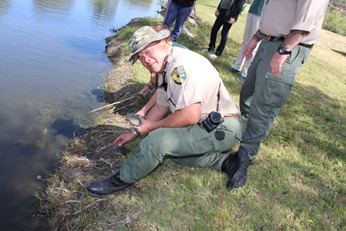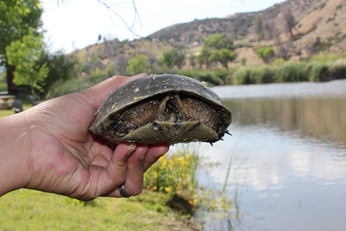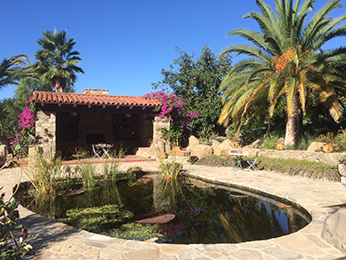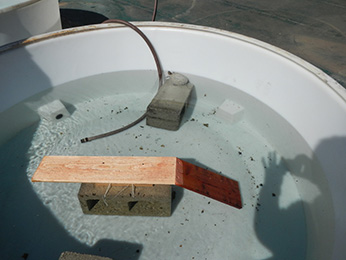What to Feed My Western Pond Turtle
UPDATE (June 2015): Lake Elizabeth Western Pond Turtle
On May 19, 2015, after over six months in captivity, the two groups of western pond turtles that had been rescued in the fall of 2014 were released near their original collection site. A total of 52 turtles, 24 from the Behlor Chelonian Center in Ojai, California and 28 from the campus of UCLA, were collected and carefully transported to The Painted Turtle camp in Lake Hughes, California, an innovative camping facility catering to children with medical conditions. The privately own Painted Turtle facility utilizes acres of watered ponds for their clients and is located on the same drainage as Lake Elizabeth only 1/2 mile upstream.
Once at the release facility, CDFW and Behlor staff carried the turtles to the bank of the largest pond and placed them a foot from the water, allowing them to enter the pond themselves. All turtles quickly entered the water without issue and quickly swam off. The release site has basking areas and quality upland habitat for the western pond turtles. Prior to release, the turtles were marked and many had PIT tags installed to track their movement.
CDFW plan's on working with the landowners to monitor the population in the future. See original story below.

CDFW's Brian Young releases western pond turtles at The Painted Turtle (May 19, 2015)

A healthy western pond turtle ready for release at The Painted Turtle (May 19, 2015)
Species Distribution
The western pond turtle, Actinemys marmoratais the only remaining freshwater turtle species native to California. The species formerly ranged from western Washington and British Columbia to northern Baja, California, with a few isolated populations along the Carson and Truckee rivers in Nevada and the Mojave River (Ernst et al., 1994).
Populations are declining in southern California as well as over most of their northern range. Habitat destruction appears to be the major cause of its decline (Brattstrom and Messer, 1988) and the species is listed as a Species of Special Concern by the California Department of Fish and Wildlife.
Necessity of Rescue
A relatively large and genetically important population of western pond turtle occurs in Lake Elizabeth, located approximately 65 miles northeast of Los Angeles in the northern Antelope Valley. This unique lake is referred to as a "sag pond" in that it is situated directly on the San Andreas Fault, and formed by the Earth's tectonic movements. In 2013, the lake level began to drop due to drought conditions and the use of the lake to suppress fires in the area. In 2014, the lake was at its lowest levels in recent history, and conditions were exacerbated by drought effects.
Relocation Sites and Turtle Survival
Starting in June of 2014 concern grew for the health of the western pond turtle population inhabiting Lake Elizabeth. Due to degrading habitat conditions, thirty-three western pond turtles were collected by the California Department of Fish and Wildlife (CDFW), United States Geological Service (USGS), and ECORP Consulting, Inc. on September 18, 2014 from the drying lake and taken to the Behler Chelonian Center in Ventura County (Figure 1). Three turtles died shortly after arriving at the facility. An additional 22 western pond turtles were collected by CDFW on October 24th and taken to the University of California, Los Angeles (UCLA) in Los Angeles County to be placed in outdoor tanks (Figure 2). Six additional turtles were collected and transported to UCLA on November 4th. There were no mortalities associated with these two rescue efforts.

Figure 1

Figure 2
Future Lake Elizabeth
The turtles will be cared for at the facilities until suitable habitat conditions return at Lake Elizabeth where they will be released back to the lake. CDFW staff will continue to monitor conditions at Lake Elizabeth.
Data
| Date | # Collected | # Mortalities | # in Captivity |
|---|---|---|---|
| September 18, 2014 | 33 | 3 | 30 |
| Octobers 24, 2014 | 22 | 0 | 22 |
| November 4, 2014 | 6 | 0 | 58 |
| Total | 61 | 3 | 58 |
Bibliography
Brattstron, B.H. and D.F. Messer. 1988. Current Status of the Southwestern Pond Turtle, Clemmys marmorata pallida, in Southern California. Final Report for the California Department of Fish and Game, Contract C-2044.
Ernst, C.E., J.E. Lovich, and R.W. Barbour. 1994. Turtles of the United States and Canada. Smithsonian Institute Press, Washington and London.
Collaborating Agencies
California Department of Fish and Wildlife, UC Los Angeles, ECORP Consulting, inc US Geological Survey, US Forest Service, Behler Turtle Conservancy
Source: http://www.wildlife.ca.gov/Drought/Projects/Western-Pond-Turtle
0 Response to "What to Feed My Western Pond Turtle"
Post a Comment